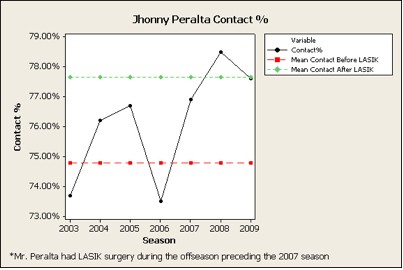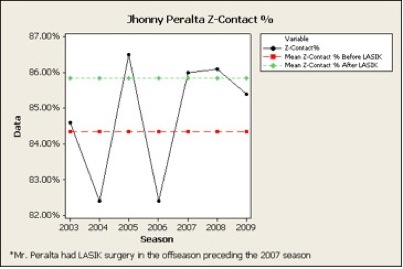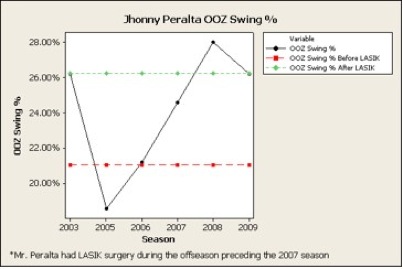BP Comment Quick Links

 | |
January 22, 2010 Under The KnifeFrickin' Laser Beams, Part 1
with Chase Gharrity Fitzgerald said the rich are not like the rest of us. If he'd been around to write about modern baseball players, he'd have learned that not only are they rich, they're not like the rest of us in other ways. A couple years ago, I was in Arizona for spring training. A player I'd gotten to know a little bit was giving me a tour of the facility when we got to the video room. I asked him about the kind of things he looked for and mentioned that he'd roughed up a highly regarded pitcher just a few days before. "Oh, he was tipping his curve," he said nonchalantly. He went on to show me how the pitcher's index finger was coming up on a curve. In slow motion, I could see it. At normal speed, even after having had it pointed out, I could barely make it out. I turned to him and said, "You can't see that in time to do anything, can you?" He gave me one of those looks; he could. The guy I know wouldn't be offended by my saying that he's no All-Star and that he's barely hung on in baseball some years. Still, he has eyes that are simply superhuman. Baseball players have always known that their eyes are their meal ticket. Rogers Hornsby refused to watch movies, thinking the flickering images could damage his eyes. Players have used all kinds of eye trainers, from the low tech to the very high tech, over the course of the game. When radial keratotomy became a surgery that was available, correcting vision was something many players considered. There's no record that a major-league player had this surgery, one that relied entirely on the skill of a surgeon. In the mid-1990s, advances in medical science brought the miracle of laser eye surgery and, shortly thereafter, the procedure now known as LASIK (Laser in-situ keratomilieusis) was developed and perfected. At a cost that was reachable by many people as a nearly cosmetic procedure, LASIK not only allowed average people to get the procedure, but it also allowed surgeons many more opportunities to perfect the craft. By the mid-2000s, a procedure known as "wavefront-guided LASIK" was the state of the art, and it remains so. In this procedure, the eye is "mapped," and then a precise, personalized surgical procedure is possible, leading not only to 20/20 vision but also, in many cases, the final result is better than that. As better outcomes and techniques made it into the mainstream, baseball players followed closely. Instead of being on the cutting edge-sports medicine normally is-baseball was a bit behind the curve. Let's face it. The eyes are not only a player's meal ticket, but it's a little bit creepy to lie back on a table and count on a surgeon to use a laser properly. That's a lot of trust for eyes worth millions. Players began to dip their toes into the LASIK waters in the late '90s, with players such as Wade Boggs and Fred McGriff among the first to try it. There does seem to be some connection here, as players from, or living in, the Tampa area are over-represented in the early LASIK roster. Attempts to reach Boggs, McGriff, and others were not returned, but it's known that the doctor, Antonio Prado, remains a sought-after consultant to many players and teams. Players at this stage tended to be high-level players attempting to hang on a couple more years. Perhaps they were more willing to take a bit of a chance in order to stay in the game a bit longer. It's very difficult to say what, if any, result was gained here, but more than anything, there was no adverse result. If Boggs or McGriff-perennial all-stars-were willing to have surgery, why wouldn't a younger guy who is trying to get a little better? How much better? There's no list out there of all the players that have had it. In fact, the teams themselves might not be able to compile a complete list. LASIK surgery is an elective procedure in most cases, handled outside the team's purview. There have been cases where the team hasn't been consulted or even informed afterward. This makes testing the effect difficult at best. Actually, it's a lot like trying to find the steroid effect. It requires a lot of legwork and a bit more guesswork than what makes the statistical gurus here at BP very happy. But that's what we did. To take a quick-and-dirty look at the potential effects of LASIK surgery, we took a look at one of the more famous players to go under the knife-er, excimer laser-for this procedure, Jhonny Peralta. This powerful Indians shortstop-turned-third baseman had always drawn positive reviews for his bat. However, Peralta posted a rough 2006 season in which he posted a .245 EqA (down from .301 EqA the previous season). He decided to have LASIK surgery performed due to his inability to see Victor Martinez's signs from his defensive position, and also due to the hot streak he produced in a trial run with contacts during the final month of the 2006 season. Peralta is no better or worse a test subject here, but he's selected more or less at "random." He's one of the few where we have clear dates and effects. During the 2007 season, Peralta saw himself bounce back to form, posting a translated EqA .022 points higher than his previous campaign. Furthermore, he improved his home run and ISO numbers by significant margins over the next two years. While there was some regression in 2009, the surface of his performance shows some hints in regards to the potential of LASIK improving player output. LASIK surgery has become a spring training cliché over the last couple of years for players looking to create buzz and writers looking to have stories during the monotonous pre-season beats. Most quotes from players who've had the surgery say they will "be able to see the spin on the ball better" or "get a better read on the release point of the opposing pitcher." Thus, we can infer that a player who has had his vision significantly enhanced would be able to make contact with the ball more, swing at more balls in the strike zone, and/or lay off pitches that travel outside of the zone. That leads us first to contact rates. With a disclaimer that we chose to include, the smaller-sized sample of the 2004 season during the following portions of the study is due to the fact that it does not fall outside of the overall form of the data. Below is a table for Peralta's contact percentage during his career, with the asterisks indicating the time the LASIK procedure took place: Year Pitches Contact% # of Pitches Contacted 2003 1054 73.70% 776.798 2004 118 76.20% 89.916 2005 2281 76.70% 1749.527 2006 2606 73.50% 1915.410 ---- ---- --- --- 2007 2545 76.90% 1957.105 2008 2502 78.50% 1964.070 2009 2546 77.60% 1975.696 Again, on the surface, the pre-surgery contact rates seem to be smaller than the post-surgery rates. This fact is reinforced by looking at the numbers visually:  Oh, but there's more. As sexy as graphs look, we're not going to be able to tell if the change in contact rate is really significant until we do a statistical test. For our purposes, we'll use a 2-Sample Proportion test. This method will allow us to see whether or not the change in contact percentage is really significant. Using the mean pre- and post-LASIK contact rates as our tested proportions, a deeper statistical look gives us this: Test and CI for Two Proportions Sample X N CONTACT % 1 4532 6059 0.747978 2 5897 7593 0.776636 Difference = p (1) - p (2) Estimate for difference: -0.0286582 95% upper bound for difference: -0.0165757 Test for difference = 0 (vs < 0): Z = -3.92 P-Value = 0.000 Fisher's exact test: P-Value = 0.000 The number we want to look at here is the P-Value. This value indicates to us the chances that, given that performance before the offseason of the LASIK surgery should be equal to the performance after the offseason, we observe a contact rate that is more extreme than the contact rate posted in the 2007-2009 seasons. The lower the P-Value, the more support for the significance of our results. Since we received a P-Value of 0, we can conclude that something fairly significant happened during the 2006-2007 offseason. Was it LASIK? We don't know for sure, but let's look at some other factors that could have been effected by the procedure. Next, let's look at Peralta's Zone Contact %, the percentage of times he made contact with a pitch that was inside the strike zone. If Peralta could see much better from 2007-09 than he could from 2003-06, we'd expect that he would make contact with higher-quality pitches, a.k.a. strikes (or non-balls) more often during his post-surgery tenure. Here are the numbers:
Pitches Contact
Year In the Zone In Zone Z-Contact%
2003 529.108 447.625 84.60%
2004 60.180 49.588 82.40%
2005 1220.335 1055.590 86.50%
2006 1370.756 1129.503 82.40%
2007 1303.040 1120.614 86.00%
2008 1268.514 1092.191 86.10%
2009 1239.902 1058.876 85.40%
Again, we can see the dip in 2006 and significant rise in overall zone contact rates from 2007-2009. More sexy:  Once more, we have our suspicions confirmed by a graph. The interesting thing here is the volatility of the pre-surgery numbers compared to the post-surgery. Even when one excludes the 28 PA season in 2004, Peralta's Z-Contact percentage is all over the place, while the post-surgery numbers are not only high, but also consistent. Using the ever-useful 2-Sample Proportion Test, we will now test if the change in Z-Contact percentage has been significantly raised during Peralta's post-LASIK seasons: Test and CI for Two Proportions Sample X N Sample P 1 2683 3180 0.843711 2 3272 3811 0.858567 Difference = p (1) - p (2) Estimate for difference: -0.0148566 95% upper bound for difference: -0.000771322 Test for difference = 0 (vs < 0): Z = -1.74 P-Value = 0.041 Fisher's exact test: P-Value = 0.044 As we can see, our P-Value is significant at the 5-percent level, or is below .05. Most stats 101 classes will tell you that .05 is the benchmark number in which one would want their P-Value to be below if statistical significance is observed. Thus, the conclusion can be made that the difference in Z-Contact percentage is significant. While we're unsure is LASIK has anything to do at all with this change, it wouldn't be a stretch to believe there would be some partial influence there. Finally, we wanted to take a look and see if Jhonny stopped swinging at bad pitches, a.k.a. pitches out of the zone, at a better clip than his pre-LASIK days, denoted in this article as OOZ Swing % (Out Of Zone Swing Percentage). Here are the numbers regarding that (Disclaimer: I decided to exclude the 2004 season due to the its small sample size and potential influence on this portion of the study):
Year OOZ Pitches OOZ Swings O-Swing%
2003 524.892 137.5217 26.20%
2005 1060.665 197.2837 18.60%
2006 1235.244 261.8717 21.20%
2007 1241.960 305.5222 24.60%
2008 1233.486 345.3761 28.00%
2009 1306.098 342.1977 26.20%
Once more with the sexy chart:  The graphical method shows something very odd: Peralta is actually swinging at more potential OOZ pitches in his post-surgery period than his pre-surgery period. Whether LASIK has something to do with this or he has simply become more aggressive with age, Peralta is taking more hacks at traditionally unfavorable pitches than ever before. Of course, a question we should ask would be: Is this change in OOZ Swing Percentage statistically significant? Let's take a look: Test and CI for Two Proportions Sample X N Sample P 1 607 2879 0.210837 2 994 3782 0.262824 Difference = p (1) - p (2) Estimate for difference: -0.0519868 95% upper bound for difference: -0.0348123 Test for difference = 0 (vs < 0): Z = -4.92 P-Value = 0.000 Fisher's exact test: P-Value = 0.000 Indeed, the rise in OOZ Swing Percentage is very significant. How paradoxical, eh? Several small-scale studies, like this one, have tried to determine whether or not LASIK surgery has positive effects on players, but there's still no definitive study that would tell us how much, if any, difference it actually makes. While the results have varied, it seems fairly plausible that Peralta probably received some benefit from the LASIK procedure. However, given the wide range of outcomes from players who have had the surgery and because we cannot isolate out other significant variables like age, we can't make any definitive statements. This all jibes with the 2004 findings of Matthew Namee. Most testing done for LASIK efficacy is focused on simple vision and the lack of "artifacts"-the visual effects, such as halo and ghosting, which are side effects of the procedure. It's no surprise that there's little done in what is a tiny fraction of LASIK cases. Without more data, we're left hoping we can quantify the effects beyond a wide but insignificant range. In fact, while the "why is LASIK all right but steroids aren't" argument actually looks a bit interesting here since both have problems of date, intent, and player quality. No one goes from has-been to All-Star. There's not even a single Henry Rowengartner-style outlier. So how, then, do we test it? There's nothing like turning yourself into a guinea pig. I'll be having wavefront-guided LASIK surgery at the end of the month. Before and after the surgery, I'll be undergoing a vision test not unlike those used by major leaguers. The first will be the simple before and after testing done by the surgeon. Then, I'll be taking a computerized vision assessment, one that will not only focus on visual acuity, but reaction time and recognition skills. This also will be done before and after. Finally, I'll be standing in the batter's box at Batter's Edge, using specially designed balls. Many teams use this as a drill, using colored dots. Ours will use small numbers, since besides being far-sighted, I'm also a bit colorblind. I'm certainly no major-league hitter, but this is something that we can control. For one man, at least, we'll know just how much of an improvement LASIK surgery is and whether baseball players are truly getting an advantage, or just getting rid of contacts and glasses. Dan Wade and the 20/20 Institute in Indianapolis provided assistance for this column.
|
While his OOZ swing percentage is up... it looks like so is his OOZ contact rate... is it possible that this reflects he's swinging at more outside-zone pitches, but that they're pitches he can drive? Just eyeballing the data on fangraphs, outside contact rate looks like it rose more-quickly that outside swing rate...
lol @ "eyeballing"